 It has been a record year for Lumber M&A activity, with >$2.2 billion of transactions during 2021 alone (more than the prior five years combined). We highlighted several potential M&A opportunities in a note last December (link), including the more “obvious” opportunities involving situations where there was either a private equity owner or non-strategic owner likely to sell. Now that many of these have already occurred, a common question we receive from investors is, “what’s left” to buy? In this note, we highlight some of the most attractive Lumber consolidation opportunities and which public companies would be most likely to be interested if the assets were to become available.
It has been a record year for Lumber M&A activity, with >$2.2 billion of transactions during 2021 alone (more than the prior five years combined). We highlighted several potential M&A opportunities in a note last December (link), including the more “obvious” opportunities involving situations where there was either a private equity owner or non-strategic owner likely to sell. Now that many of these have already occurred, a common question we receive from investors is, “what’s left” to buy? In this note, we highlight some of the most attractive Lumber consolidation opportunities and which public companies would be most likely to be interested if the assets were to become available.
Why more consolidation? We think the consolidation will make Lumber a more attractive business over time. In OSB markets, we have slowly seen increased consolidation result in higher average margins and a more rapid industry response to periods of low OSB prices. While it has taken longer to consolidate the lumber industry, we expect that West Fraser, Canfor, Interfor, and Weyerhaeuser will continue to play a key role in making the lumber business more attractive (although the last two years have left little to complain about).
For lumber producers, we think that geographic diversification is top of mind given that changing political and natural environments can negatively impact operations. Of the major producing regions, we view the US South as the most attractive region for growth followed by Alberta, the Pacific Northwest, and Eastern Canada. For producers with operations in British Columbia, the urgency to diversify production outside the high-risk province will be greater. We think that Canfor and potentially West Fraser could look to further diversify lumber production by expanding in Europe.
Finally, we expect that larger and publicly traded lumber producers will look to reduce volatility. Prior to its acquisition by West Fraser, Norbord notably introduced a “variable operating schedule” to match its own supply to market demand. This has prevented too much OSB from being produced despite record prices. We expect that as the Lumber industry becomes more consolidated, industry margins will become less volatile.
What’s left?
US South. Given the elevated valuations on recent US South transactions and premiums vs. other regions, we think that privately owned US South sawmills could look to monetize. Although ownership of US South sawmills has increased over the years (we estimate ~46% of US South capacity is now owned by publicly traded lumber producers), there is still a long runway for consolidation with ~13.5 bbf of US South capacity operated by privately held producers. Producers in the region that we think would be the most attractive acquisition targets include: 1) Anthony Timberlands; 2) Biewer Lumber; 3) Collum’s Lumber; 4) Jordan Lumber; 5) Langdale Forest Products; 6) Mission Forest Products; 7) Rex Lumber; 8) Two Rivers Lumber; 9) Vicksburg Forest Products; and, 10) The Westervelt Company.
Other North America. Despite recent consolidation, we think there are still some attractive acquisition opportunities outside the US South. We think some of the most attractive acquisition targets in other regions could include: 1) Alta Forest Products; 2) GreenFirst Forest Products; 3) RSG Forest Products; 4) Stimson Lumber; and, 5) Vanderwell. Idaho Timber, with operations in several regions, could also be attractive given its larger size.
Europe. We expect that both Canfor and West Fraser will look to grow in Europe over the next few years, with a particular focus on Scandinavia and Western Europe. In Scandinavia, we think ATA Timber, Derome Timber, SCA’s Wood Division, Setra Group, or Versowood could be a good fit.
